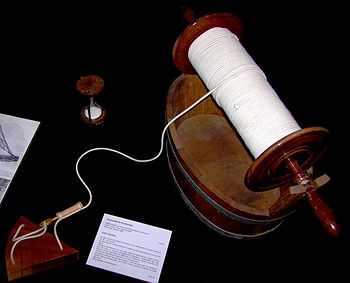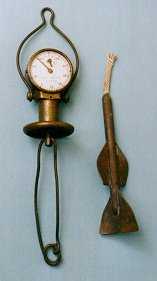Chip log
A chip log, also called common log, ship log or just log, is a navigation tool used by mariners to estimate the speed of a vessel through water. The name of the unit knot, for nautical mile per hour, was derived from this method of measurement.
History
All nautical instruments designed to measure the speed of a ship through water are known as logs.[1] This nomenclature dates back to days of sail when sailors tossed a log attached to rope knotted at regular intervals off the stern of a ship. The sailors would count the number of knots that passed through their hands in a given period of time. Today sailors still use the unit of knots to express a ship's speed. The speed of the ship was needed to navigate the ship using dead reckoning, which was standard practice in the days before modern navigation instruments like GPS.
Construction


From the Musée de la Marine, Paris.
A chip log consists of a wooden board attached to a line (the log-line). The log-line has a number of knots tied in it at uniform spacings. The log-line is wound on a reel to allow it to be paid out easily in use.
Over time, the log was standardized in construction. The shape is a quarter circle, or quadrant, and the log-line is attached to the board with a bridle of three lines connected to the vertex and to the two ends of the quadrant's arc. In order to ensure that the log submerges and is oriented correctly, the bottom of the log is weighted with lead. This provides for more resistance in the water and a more accurate and repeatable reading of speed. The bridle is attached in such a way that a strong tug on the log-line results in one or two of the bridle's lines releasing, allowing the log to be retrieved with relative ease.
Usage
When the navigator wished to determine the speed of his vessel, a sailor dropped the log over the stern of the ship. The log would act as a drogue and remain roughly in place while the vessel moved away. The log-line was allowed to run out for a fixed period of time. The speed of the ship was indicated by the length of log-line passing over the stern during that time.
Origins
The first known device to measure speed is often claimed to be the Dutchman's Log. However this invention is attributed to the Portuguese Bartolomeu Crescêncio, who designed it in the end of 15th century or in the beginning of 16th century.[2] An object that would float was thrown overboard and the time required to pass between two points on deck was measured with a sandglass. However, the first reference to a Dutchman's log is in 1623, after the ship log.[3] The Dutchman's log could be used with a brass tobacco box, rectangular with rounded ends. This box had tables on it to convert log timing to speed.[4][5]
The log has been used by mariners for a long time. The first occurrence of a description of the device in print was in A Regiment for the Sea by William Bourne in 1574.
Initially, the log-line was not knotted and the length was measured directly on the line. With the introduction of the nautical mile as a standard unit of measure at sea in the 15th century, the line began to be marked at equal intervals proportional to the nautical mile and to the time interval used for measurement. Initially, the markings were in the form of knots in the line. Later, knotted cords were worked into the log-line.
Originally, the distance between marks was 7 fathoms or 42 feet used with a sandglass with a 30 second running time. Later refinements in the length of the nautical mile caused the distance between knots to be changed. Eventually, the distance was set to 47 feet, 3 inches (14.4 meters) for a standard glass of 28 seconds.
Accuracy and considerations by the navigator
The use of a log did not give an exact measure of speed. A number of considerations had to be taken into account, for example:
- the amount of following sea
- the effect of currents
- stretch of the line
- inaccuracies in the measurement of elapsed time. Sandglasses were affected by ambient temperature, humidity, and sea state.
Frequent measurements helped in mitigating some of these inaccuracies by averaging out individual errors, and experienced navigators could determine their speed through the water with a fair degree of accuracy.
Because a log measures the speed through the water, some errors, especially the effect of currents, that is the movement of the water itself, can not be corrected for. Navigators rely on position fixes to correct for these errors.
Modern navigation tools such as GPS report speed over ground and in general will not give the same results as a log when currents are present.
More modern logs and replacements

Mechanical speed logs called patent logs or taffrail logs, operating on physical principles in a manner similar to a car's odometer by towing a vane or rotor from the stern (or taffrail) by a long line were developed in the eighteenth century (or earlier) but became practical in the nineteenth century and replaced the traditional chip log.[6] Since the second half of the twentieth century, more modern mechanical and electro-mechanical versions based upon a small impeller or paddle wheel attached to (or through) the bottom of the hull continue to be used especially on smaller yachts.
In recent years ultrasonic speed sensors have become available. These new type use two ultrasonic transducers one forward, one aft that send ultrasonic pulses through the water flow past the hull. By calculating the time differential in pulse propagation from one sensor to the other, the speed of the hull through the water can be calculated directly.
Today, the most accurate means of maritime speed measurement comes from Doppler measurement, either derived acoustically by use of Doppler Sonar or radio interferometrically by Doppler measurement of satellite signals such as those from Global Positioning System (GPS). Most commercial GPS systems are not configured to operate in this mode, however.
See also
- Pitometer log (pit log) - a more modern form of log operating on the principle of differential pressure
- Dead reckoning - a form of navigation which depends on speed measurement
- Traverse board - a traditional tool used aboard ship to keep track of speed and heading
References
- ↑ "The Dictionary of English Nautical Language Database". MacKenzie, Mike. Retrieved 17 June 2012.
- ↑ URL:http://www.cienciaviva.pt/projectos/concluidos/inventions/instrumentos.asp Agência Nacional para a Cultura Científica, Ciência Viva, Descobertas e Invenções Portuguesas (in Portuguese)
- ↑ May, William Edward, A History of Marine Navigation, G. T. Foulis & Co. Ltd., Henley-on-Thames, Oxfordshire, 1973, ISBN 0-85429-143-1
- ↑ Turner, Gerard L'E., Antique Scientific Instruments, Blandford Press Ltd. 1980 ISBN 0-7137-1068-3
- ↑ The ‘Dutchman’s Log’ or the Seaman’s Tobacco Box of Pieter Holm
- ↑ Broelmann, J (1998). Robert Bud and Deborah Warner, ed. Instruments of Science. An Historical Encyclopedia: Logs. New York, London. pp. 361–363.
- The Oxford Companion to Ships and the Sea, Peter Kemp ed., 1976 pp 192–193. ISBN 0-586-08308-1
External links
- Chip Log pattern on the webpage of the Navy & Marine Living History Association, Inc. note: the distance given in the materials list for this pattern is 33⅓ feet, but part C of "Construction" uses the modern distance of 47¼ feet.